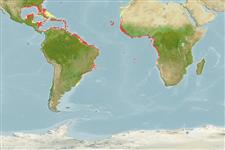>
Eupercaria/misc (Various families in series Eupercaria) >
Gerreidae (Mojarras)
Etymology: Eucinostomus: Greek, eu = good + Greek, kyon = dog + Greek, stoma = mouth (Ref. 45335).
More on author: Bleeker.
Environment: milieu / climate zone / depth range / distribution range
Οικολογία
Θαλασσινό(ά); Γλυκού νερού; Υφάλμυρο βενθικό(ς); αμφίδρομο (Ref. 51243); εύρος βάθους 0 - 25 m (Ref. 2683). Subtropical; 33°N - 34°S, 98°W - 14°E
Eastern Atlantic: west African coast, from Senegal to Angola (Ref. 57394). Also reported from Mauritania (Ref. 5377, 7352). Western Atlantic: Bermuda and Florida, USA to Brazil; not found in the Bahamas (Ref. 7251).
Μέγεθος / Βάρος / Age
Maturity: Lm ? range ? - ? cm
Max length : 30.0 cm TL αρσενικό/απροσδιόριστο; (Ref. 2683); common length : 23.0 cm TL αρσενικό/απροσδιόριστο; (Ref. 2683); μεγ. δημοσιευμένο βάρος: 26.50 g (Ref. 118626)
Short description
Μορφολογία | Μορφομετρία
Ραχιαίες άκανθες (συνολικά): 9; Μαλακές ραχιαίες ακτίνες (συνολικά): 10; Εδρικές άκανθες 3; Μαλακές εδρικές ακτίνες: 7 - 8. Diagnosis: body fusiform and compressed; snout pointed; mouth strongly protrusible; nostrils contiguous, positioned nearer to eye than to snout tip; dorsal fin deeply notched; tips of pectoral fins not reaching to anal-fin origin; scales cycloid on head and finely ctenoid on body; scales of interocular space reaching anterior border of eyes; tip of spinous dorsal fin with a black spot, underlined by a whitish band (Ref. 57394).
Coloration: back olivaceous, sides silvery; a characteristic black spot at tip of spiny part of dorsal fin; young individuals may show dark vertical bars on back and sides (Ref. 57394).
A coastal species entering estuaries, lower courses of coastal rivers, and lagoons (Ref. 4323, 7352, 57394). Found over sand or mud bottoms (Ref. 3722, 57394). Feeds on fish, shrimps, mollusks, zooplankton and detritus (Ref. 28587); including other benthic crustaceans and polychaetes. Forages at daytime in small groups, hovering close to the bottom and either picks off prey on the substrate or digs into it sifting the mouthed sediment through its opercular openings. Its conspicuous black tip on dorsal fin is mimicked by juvenile guianan snooks, Centropomus mexicanus, an example of aggressive mimicry (Ref. 43465). Marketed fresh but not highly esteemed (Ref. 3722).
Life cycle and mating behavior
Γεννητική Ωρίμανση | Αναπαραγωγή | Γεννοβολία | Αβγά | Γονιμότητα | Προνύμφες
Roux, C., 1990. Gerridae. p. 781-782. In J.C. Quero, J.C. Hureau, C. Karrer, A. Post and L. Saldanha (eds.) Check-list of the fishes of the eastern tropical Atlantic (CLOFETA). JNICT, Lisbon; SEI, Paris; and UNESCO, Paris. Vol. 2. (Ref. 7352)
IUCN Red List Status (Ref. 130435)
Threat to humans
Harmless
Human uses
αλιεία: περιορισμένης εμπορικότητας
Περισσότερες πληροφορίες
ΑναφορέςΥδατοκαλλιέργειεςΠροφίλ υδατοκαλλιέργειαςΣτελέχοιΓενετικήElectrophoresesΚληρονομικότηταΑσθένειεςΜεταποίησηNutrientsMass conversion
ΣυνεργάτεςΦωτογραφίεςStamps, Coins Misc.ΉχοιΣιγκουατέραΤαχύτηταΚολυμβητικός ΤύποςΕπιφάνεια βραγχίωνOtolithsΕγκέφαλοιΌραση
Εργαλεία
Special reports
Download XML
Διαδικτυακές πηγές
Estimates based on models
Preferred temperature (Ref.
123201): 23.4 - 28, mean 27.1 °C (based on 1079 cells).
Phylogenetic diversity index (Ref.
82804): PD
50 = 0.5010 [Uniqueness, from 0.5 = low to 2.0 = high].
Bayesian length-weight: a=0.01047 (0.00829 - 0.01322), b=3.08 (3.04 - 3.12), in cm total length, based on LWR estimates for this species (Ref.
93245).
Τροφικό Επίπεδο (Ref.
69278): 3.4 ±0.52 se; based on food items.
Ελαστικότητα (Ref.
120179): Υψηλό, ελάχιστος χρόνος για διπλασιασμό πληθυσμού < 15 μήνες (Preliminary K or Fecundity.).
Fishing Vulnerability (Ref.
59153): Low vulnerability (20 of 100).
Nutrients (Ref.
124155): Calcium = 117 [60, 236] mg/100g; Iron = 1.11 [0.58, 2.04] mg/100g; Protein = 19.5 [17.6, 21.3] %; Omega3 = 0.365 [0.198, 0.650] g/100g; Selenium = 18.3 [9.5, 36.3] μg/100g; VitaminA = 11.8 [3.7, 32.6] μg/100g; Zinc = 1.01 [0.70, 1.44] mg/100g (wet weight);
